Introduction
Layer 2 solutions have emerged as a game-changer in the world of blockchain technology, indeed. Of course, Immutable X is on of the protocols from layer 2.
Layer 2 protocols have become an integral part of the crypto ecosystem since need for scalability and reduced transactions costs. But what exactly are layer 2 solutions?
In simple terms, layer 2 refers to a secondary framework built on top of an existing blockchain network. They are enhance its performance and efficiency, obviously. Layer 2 protocols operate by processing transactions off-chain and then settling them on the main blockchain. So, let’s go read little bit about advantages of using layer 2 protocols.
Advantages of Layer 2 Protocols
Surely, layer 2 solutions bring bunch of advantages.
In fact, one of the key benefits is scalability. Traditional layer 1 blockchain networks are Bitcoin and Ethereum. They face limitations in terms of the number of transactions per second.
Layer 2 protocols address this issue by enabling a higher throughput, indeed. Then, allowing for faster and more efficient transactions.
In addition to scalability, layer 2 solutions also offer reduced transaction costs. Then, users can avoid the high gas fees associated with on-chain transactions. In fact it’s great choice for microtransactions and everyday use cases.
Another advantage of layer 2 protocols is improved privacy. In this case transactions off-chain are the key.
In fact they can provide enhanced privacy features, protecting sensitive information from being exposed on the main blockchain. This is particularly important in applications that require secure and confidential transactions. Such as financial services and healthcare.
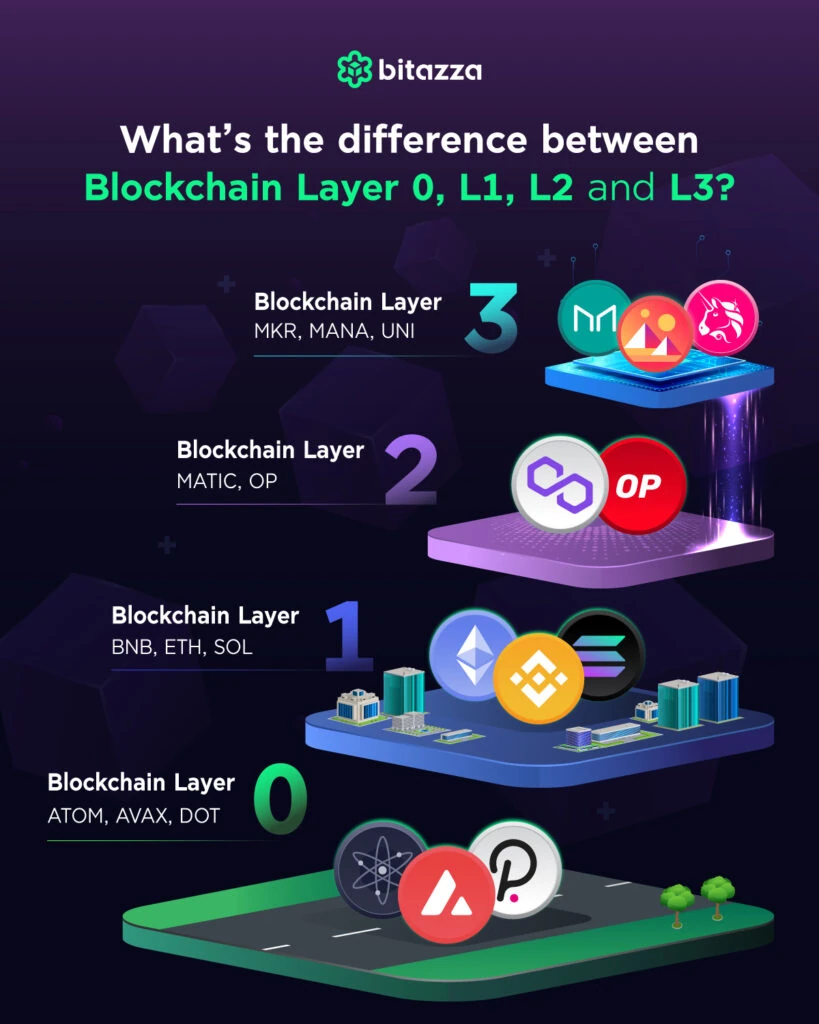
Generally speaking, the layers differ in their functions, but writing this I am not much of an explorer.
Rather, my goals are to show the hierarchy of projects in the blockchain layers.
ATOM, Avalanche and also Polkadot represent layer 0. Then we have layer 1, i.e. projects such as Binance Coin, Solana or Ethereum. Next, there is a layer built on layer 2, i.e. layer 3, which includes projects such as Polygon, Immutable X and Optimism.
In layer 4, you will find Maker, Decentraland and also Uniswap, but not only.
Layer 1 vs Layer 2
Firstly, let’s compare layer 1 and layer 2 blockchains. As a matter of fact, layer 1 refers to the main blockchain network, where all transactions are processed and settled.
While layer 1 blockchains are the foundation of the crypto ecosystem. But, they often face limitations in terms of scalability and transaction costs.
Layer 2 solutions, on the other hand, aim to address these limitations. Because they building an additional layer on top of the main blockchain.
Significant portion of the transactional load off-chain, so layer 2 protocols can achieve higher scalability and lower transaction costs. This is achieved through various techniques, such as state channels, sidechains, and plasma chains.
Additionally, layer 2 solutions offer faster transaction speeds compared to layer 1 blockchains.
Since transactions are processed off-chain and settled periodically on the main chain, users can experience near-instantaneous transaction confirmations.
This makes layer 2 solutions ideal for applications that require real-time transactions, such as gaming and decentralized finance (DeFi).
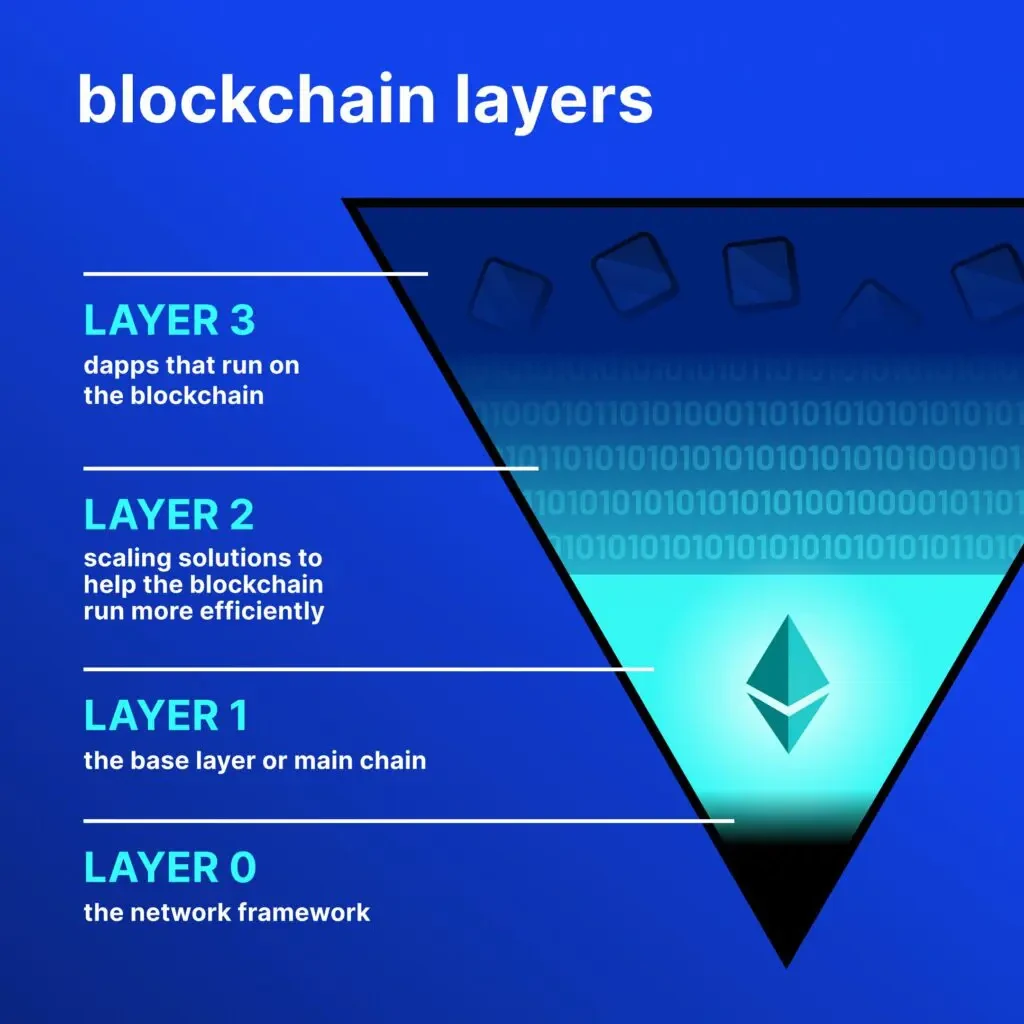
Blockchain not only has 2 layers, but in this article I focus on describing only two.
Indeed, 2 layers is the scalability layer of blockchain projects.
Basically, layer 1 is the main layer.
In the case of Immutable X (layer 2) it has a base in the Ethereum project (layer 1), in reality.
I will write about layers 0 and 3 another time. Then I will devote an entire article to blockchain layers.
Exploring Immutable X
In truth, Immutable X is one of the prominent layer 2 solutions.
In fact, Immutable X aims to provide scalable and efficient solutions for decentralized applications (dApps).
At its core, Immutable X utilizes a technique called Zero-Knowledge-Rollups (ZK-Rollups). Then, by that achieve scalability and reduce transaction costs. Isn’t it cool, indeed?
Firstly, ZK-Rollups allow for bundling multiple transactions together. Finally, submitting a single proof to the main chain.
This approach significantly reduces the computational overhead required for processing transactions. So they are faster and cheaper.
In addition to scalability, Immutable X also offers a high level of security.
Immutable X ensures that transactions settled on the main chain are fully secure and tamper-proof, surely.
This makes it an ideal choice for applications that require a high level of trust and security, such as digital collectibles and non-fungible tokens (NFTs).
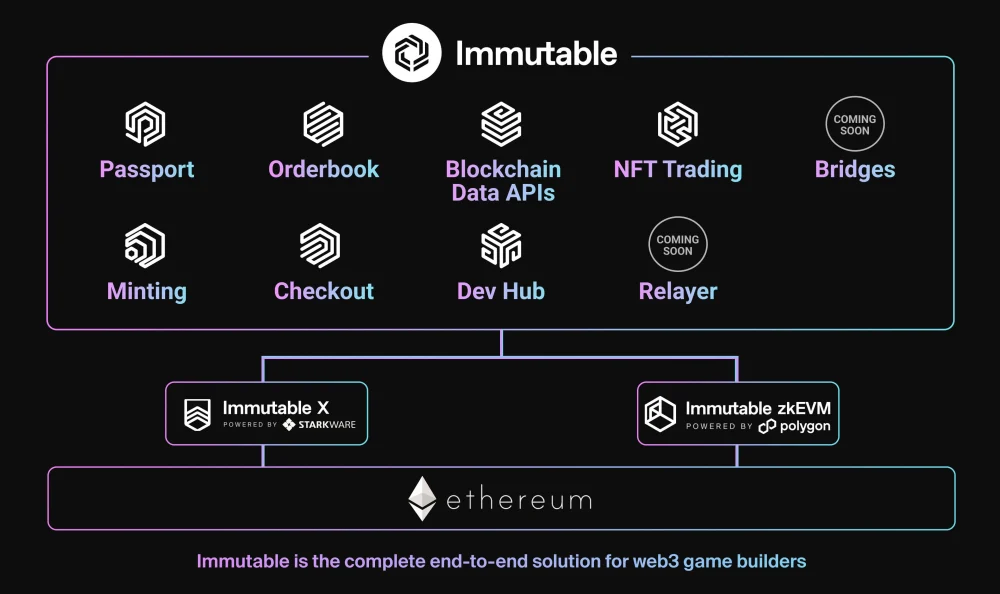
Without a doubt, Immutable X is a good solution for people looking for Web 3 solutions.
You should already know something about Web 3.
As you can see, Immutable X is built on Ethereum and uses scalability and transaction efficiency in its project while collaborating with Polygon.
Project also focuses on solutions aimed at Web3 users and developers.
The Power of Layer 2 and Immutable X
Immutable X use power of layer 2. Then providing a scalable and efficient infrastructure for Ethereum-based dApps.
Immutable X is able to process a large number of transactions off-chain and settle them on the Ethereum blockchain periodically. ZK-Rollups are great, in this case.
This approach significantly increases the throughput of the network, allowing for faster and more efficient transactions.
In addition to scalability, Immutable X also addresses the issue of high transaction costs.
By aggregating multiple transactions into a single proof on the main chain, Immutable X reduces the computational overhead required for processing transactions.
This results in lower fees for users, making it an attractive option for applications that require frequent and low-cost transactions.
Furthermore, Immutable X ensures the security and integrity of transactions by leveraging the underlying security of the Ethereum blockchain. By settling transactions on the main chain, Immutable X ensures that they are fully auditable and tamper-proof.
This provides users with a high level of trust and confidence in the platform.
Use Cases for Immutable X
Immutable X and layer 2 solutions have a wide range of use cases across various industries. One of the primary use cases is gaming.
Especially, scalability and low transaction costs are crucial for a seamless gaming experience. Because blockchain-based games and virtual economies growing fast.
Layer 2 protocols, such as Immutable X, enable developers to build scalable and efficient gaming platforms, where players can trade virtual assets and conduct in-game transactions without the limitations of layer 1 blockchains.
Another use case for Immutable X and layer 2 crypto is decentralized finance (DeFi).
DeFi applications have gained significant traction in recent years, offering users various financial services, such as lending, borrowing, and trading, without the need for intermediaries.
However, the high gas fees and slow transaction speeds of layer 1 blockchains have been a major challenge for DeFi.
Layer 2 solutions, including Immutable X, provide a scalable and cost-effective infrastructure for DeFi applications, enabling users to access these services more efficiently.
Key Players in the Layer 2 Ecosystem
The layer 2 ecosystem consists of various key players.
Without a doubt, one of the prominent players is Ethereum. In fact, it’s foundation for layer 2 protocols like Immutable X.
Ethereum’s scalability efforts play a crucial role in enabling layer 2 solutions to thrive.
Another key player in the layer 2 ecosystem is the developer community.
Developers are essential for building and optimizing layer 2 protocols.
Because creating applications that leverage the benefits of layer 2 solutions.
Their innovative ideas and contributions drive the evolution of layer 2 technology and its adoption across different industries.
Furthermore, various technology companies and startups are actively involved in the layer 2 ecosystem.
These companies specialize in developing layer 2 solutions, providing infrastructure support, and offering tools and services for developers and users.
Their efforts are instrumental in driving the adoption of layer 2 solutions and expanding the capabilities of the crypto ecosystem.
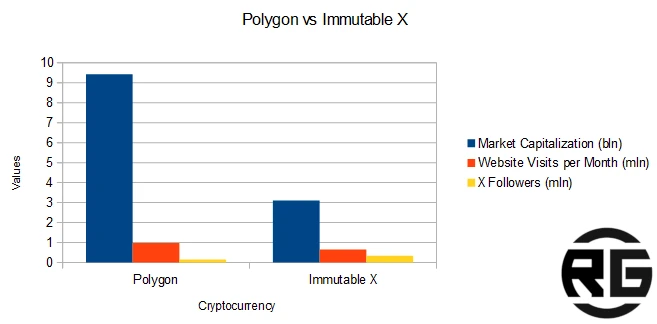
In fact, Polygon is better compared to Immutable X.
Only the number of people following the X platform is higher in the case of Immutable X.
All this is due to disruptions in the Polygon team in recent months.
Either way, in layer two of the blockchain, Polygon is the leader. So, Immutable X must recognize its superiority.
Indeed, you could have learned from this article about the cooperation of two projects.
Challenges and Limitations
While layer 2 solutions offer numerous advantages, they also come with their own set of challenges and limitations.
One of the primary challenges is interoperability, surely. As layer 2 protocols are built on top of existing blockchains, so they need to ensure compatibility with different blockchain networks.
It’s crucial for the widespread adoption intagrate layer 1 blockchains and also layer 2.
Another challenge is the complexity of layer 2 protocols. Implementing and integrating layer 2 solutions require expertise and technical knowledge, so it can be a barrier for developers and users.
Simplifying the deployment and usage of layer 2 solutions is essential for their mass adoption and usability.
Additionally, layer 2 solutions need to address the issue of security. While settling transactions on the main chain ensures the security of layer 2 solutions, vulnerabilities may still exist at the layer 2 level.
Immutable X Price in Depth
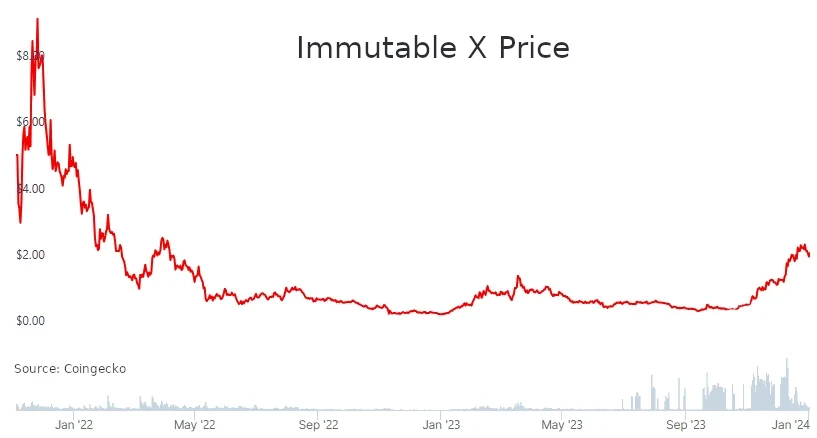
As like always I am reffering to graph taken from Coingecko
There isn’t really much to write about the price of this cryptocurrency. About 1 year on the cryptocurrency market.
The listing of the cryptocurrency itself almost coincided with the end of the bull market, which was certainly the intended goal. However, I will try to write something sensible.
Since cryptocurrencies are at the top with a capitalization exceeding USD 3 billion. It’s a good sign, but I will come back to this point in a moment. I don’t want to start at the end, in fact.
1st Bull Market
Well, even though Immutable X was released at the very end of the bull market, the price still jumped to a peak of $9.52 per unit. Surely, it’s much or little? In my opinion, a lot!
The rationale is quite simple. It was a fresh design at the time. It was probably quite well advertised, but there were more reliable projects on the market. After a few days of bull market, so…
The project might as well have gone unnoticed, whatever. Such a scenario was also possible.
Bear market
In my opinion, the project was late with the listing or it was a deliberate move.
Either way, the price dropped $0.31 per unit. During one year, which is traditionally how long the bear market lasts.
A drop of 97%!! I can’t explain this move in common sense.
Releasing projects before the end of the bull market. What for?
A typically speculative move. In my opinion, this is only so that the team can make money on the ending boom.
I don’t know if I’m wrong, but there should be some logic here somewhere?
It’s true that markets are not governed by the laws of logic, but by the psychology of investing or trading, but the project could just as easily have been released 1 month later. Isn’t it?
2nd Bull Market
2 bull market is moving in a sideways trend.
It is true that it could be seen that in 2023 the price was in a slight upward trend, but only taking into account the entire year. Well, today’s price is $2.26 per unit.
The price is far from the bottom, and the period before Bitcoin’s halving begins. I will write an article about the halving itself, but why not?
Layer 2 Adoption and Future Trends
Layer 2 adoption has been gaining momentum in recent years, surely.
In fact, scalability and transaction costs continue to be key concerns in the blockchain space. So, layer 2 protocols provide a viable solution for addressing these challenges.
Indeed, let’s see increased collaboration and interoperability between layer 2 solutions and layer 1 blockchains.
Moreover, advancements in layer 2 technology, such as the integration of zero-knowledge proofs and other scalability techniques, will further enhance the capabilities of layer 2 solutions. It will be even greater scalability, faster transaction speeds, and improved privacy features, surely.
Conclusion
Layer 2 solutions, such as Immutable X, have revolutionized the blockchain industry by offering scalable and efficient solutions for decentralized applications.
Surely, layer 2 protocols enhance the scalability and reduce the transaction costs of blockchain networks.
Immutable X, in particular, harnesses the power of layer 2 to provide a scalable and secure infrastructure for Ethereum-based dApps. As layer 2 adoption continues to grow, we can expect to see more innovative use cases, indeed.

Leave a Reply
You must be logged in to post a comment.